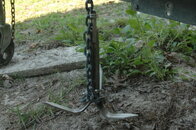When, like the OP, I/we dive from my 19 foot boat, I do not have a rescue diver on ready or a recompression chamber. I do leave my wife aboard and go solo unless the conditions are especially benign in which case we leave the boat alone if she wishes to dive and we are within swimming distance of the shore (for me that would be several miles even towing my wife). We anchor and tie to the wreck, as is legal and if not I anchor beside the wreck. I don't use the tie-wraps or twine to tie the chain in the "release" method. I do stay within sight of the anchor once on bottom and content myself with some macro shots or just watching what comes by, especially so if my wife has joined me. We do carry safety equipment such as a signal mirror, flare, dye pack, and now we have a PLB which I will soon be making a carry case for from a PVC tube.
Once a few decades ago, people dived/fished from much smaller boats much further from shore and it was routine, they did not have rescue divers, recompression chambers on board, electronic locators or 33 footer, triple engine, 90 MPH center consoles, more likely it was a BW Montuck or even a BW 13 footer or a little Mako 17 or similar.
You know, if my boat floats away, because my wife falls asleep and if my PLB does not work and if we are the only people on the ocean because they have all been raptured including my wife to use my dye, flares, mirror to signal and if I am setting there all by myself, I will just swim to shore, 10 miles is possible, I don't care. Safety is important but I cannot paralyze myself for fear of the ridiculous possibility into doing nothing due to today's hyper safety consciousness concerning every facet of life. Live strong, not forever.
N






